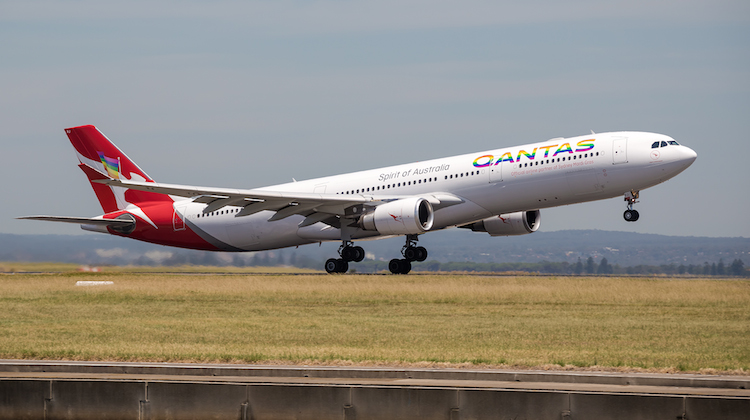Qantas has scheduled Hong Kong as the first Asian destination with its Boeing 787-9 fleet, with flights to the Special Administrative Region to begin in mid-December.
The first 787-9 service to Hong Kong is due to take off on December 13 2018, when the aircraft replaces the Airbus A330 on Qantas’s daily Melbourne-Hong Kong service for five flights a week, increasing to six flights a week from January 28 2019 to March 29 2019.
Brisbane-Hong Kong, which Qantas flies daily, gets one 787-9 service a week to Hong Kong from December 19 2018, increasing to two flights a week from January 30 2019.
Finally, Qantas will operate the 787-9 six times a week between Sydney and Hong Kong from March 30 2019. As Qantas flies this route twice daily, the remaining services will be operated with A330 or A380 equipment, depending on the time of the year.
While the Dreamliner has fewer seats than the A330s and 747s it is replacing on the Hong Kong route, there is a higher proportion of premium seats on board.
Qantas’s 787-9s feature 236 seats comprising 42 in business class in a 1-2-1 configuration offering direct aisle access for every passenger, 28 in premium economy laid out 2-3-2 across and 166 in economy in a 3-3-3 layout with 32in seat pitch and 17.2in seat width.
By contrast, the 10 A330-300s in the Qantas fleet have 287 seats, with 28 in business class and 269 in economy.
Meanwhile, the airline’s 18 two-class A330-200s, which are mostly deployed on domestic routes, have either 287, 271 or 251 seats, depending on configuration.
“Introducing the Dreamliner to Hong Kong reinforces our commitment to Asia, where we are seeing strong demand from premium travellers,” Qantas international chief executive Alison Webster said in a statement on Tuesday.
“The combination of our 787, A330 and A380 aircraft operating between Australia and Hong Kong over the peak season will see customers enjoy a premium inflight experience on every flight.”
Meanwhile, the use of the 787-9 to Hong Kong would free up A330s to either increase capacity on domestic routes or mount additional flights to existing Asian destinations.
Currently, Qantas uses four 787-9s to operate a Los Angeles-Melbourne-Perth-London Heathrow rotation.
From September 1, it will also be used on the Melbourne-San Francisco route four times a week.
The start of those flights would also coincide with a rebalancing of Qantas’s capacity between Melbourne and the United States, with the six-times weekly 787-9 Melbourne-Los Angeles flights trimmed back to two flights a week.

Hong Kong means no new US route for Qantas for now
The choice of Hong Kong as the newest destination in the 787-9 network suggested Qantas had, for now, decided against opening up a new gateway in North America.
That possibility was raised a year ago in August 2017 when Qantas said it would base four 787-9s at Brisbane.
At the time, Qantas was keen to highlight the potential of a new long-haul route from Brisbane thanks to the next generation Boeing widebody, noting in its statement the 787-9 was capable of flying from Brisbane to Chicago, San Francisco, Seattle and Vancouver in North America, in addition to operating Asian routes.
“We’ve said that initially our Dreamliners will replace the routes that our older 747s fly but there are also new destinations we are looking at given the capability of the aircraft,” Qantas chief executive Alan Joyce said.
“A range of exciting options is on the table that will help drive tourism to the state and we look forward to making that decision in coming months.”
The Brisbane-based 787-9 fleet will from September 1 replace the 747-400 on the daily Brisbane-Los Angeles-New York rotation. The 747-400 will operate an additional three flights a week between Brisbane and Los Angeles to help offset the reduction in available seats on the route.
The 747-400 will then disappear from the route completely from December 1, with the 787-9 to operate on Brisbane-Los Angeles 11 times a week.
A Qantas spokesperson told Australian Aviation on Tuesday the airline was always reviewing and considering new destinations, including those in the US.
The fifth 787-9 in Qantas colours arrived in Australia in early July, with three more due by the end of calendar 2018.
Looking further ahead, Qantas has firm orders for six more 787-9s due to arrive between late 2019 and mid-to-late 2020.
This batch of six will lead to the withdrawal of the 747 fleet by the end of 2020 and as the airline celebrates its 100-year anniversary.
“The 787 has better economics and a longer range, and it has already opened up new routes like Perth to London,” Joyce said on May 2.
“With a larger fleet of Dreamliners, we’ll be looking at destinations in the Americas, Asia, South Africa and Europe.”
Qantas is currently waiting on a decision from the United States Department of Transportation (DoT) on its proposed expanded alliance with American Airlines on trans-Pacific routes.
How the DoT, which rejected the two carrier’s first application in 2016, rules may influence the airline’s decisions on its North American network.
Hong Kong a sensible move for Qantas: analyst
Chief analyst at aviation thinktank CAPA – Centre for Aviation Brendan Sobie said the use of the 787-9 to an existing Qantas market such as Hong Kong was a surer bet than launching a new North American route.
“The fact Qantas has shied away from launching a new long haul from Brisbane is disappointing for Brisbane Airport and Queensland consumers,” Sobie told Australian Aviation on Tuesday.
“However, it is a sensible move for Qantas given the relatively unattractive economics of the potential Brisbane-US routes.
“Any new Brisbane-US route would be high risk while deploying the last 787 in Asia is very low risk.”
VIDEO: How Qantas’s fourth 787-9, named Emily Kame Kngwarreye, was painted, as shown on the Qantas YouTube channel.










